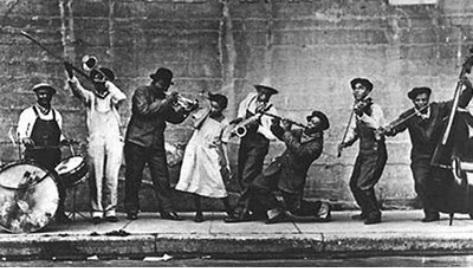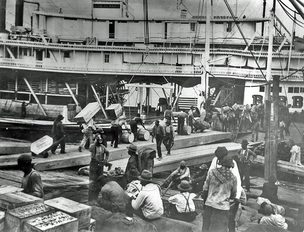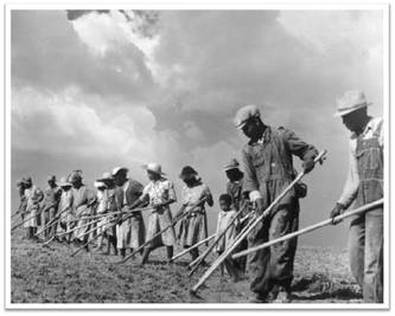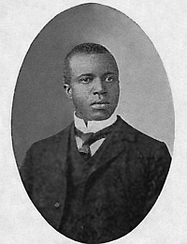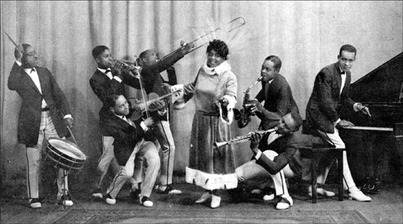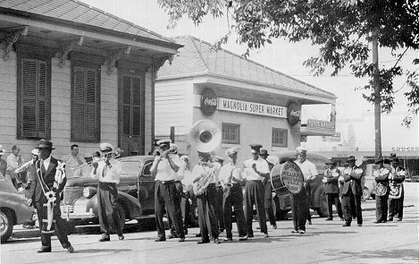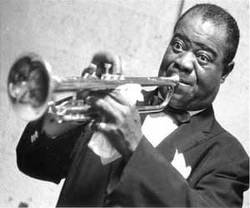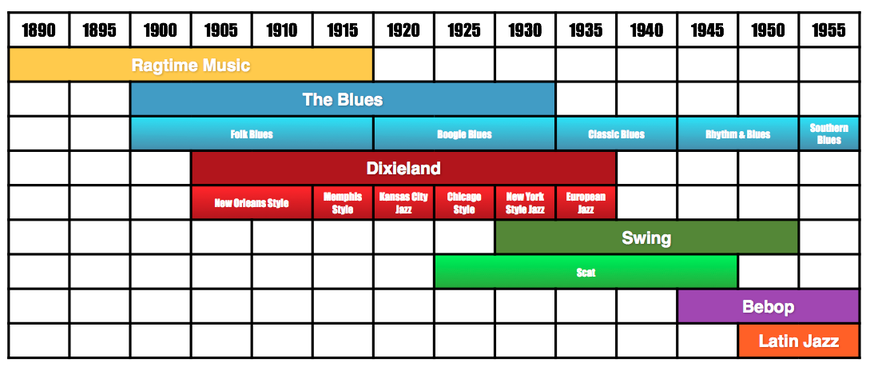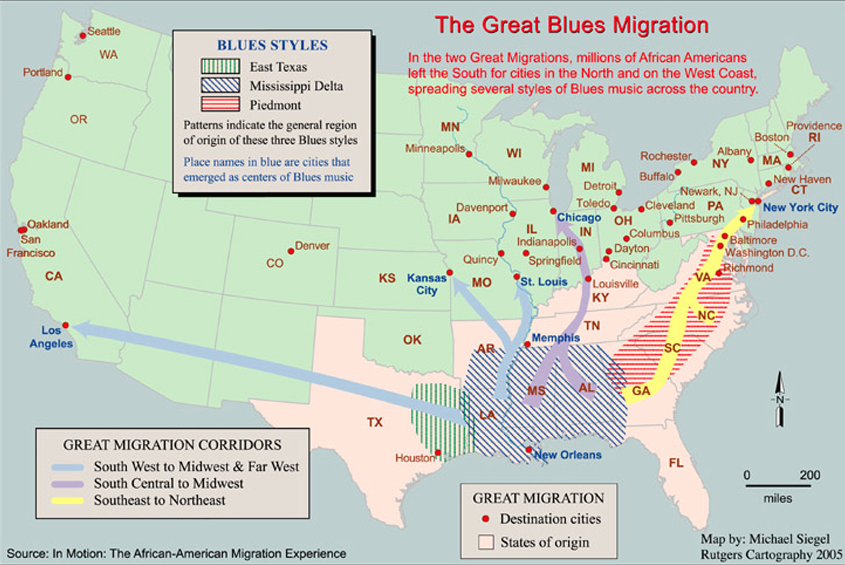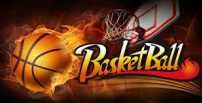THE FIRST AMERICAN ART FORM
YOUR MISSION
Know what you will be able to do when the lesson is over.
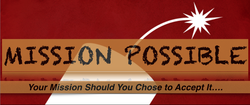
I can describe how Jazz developed and explain why it spread in the 1920s.
YOUR PORTFOLIO
Prepare the header for your portfolio entry for today. List the entry in your table of contents.
Name Homeroom
Lesson 7.3: The First American Art Form
Lesson Mission: I can describe how Jazz developed and explain why it spread in the 1920s.
CLASS READING
As a class, we will take turns reading the class reading below.
Dixieland Jazz
The following information was obtained from the Thelonious Monk Institute of Jazz.
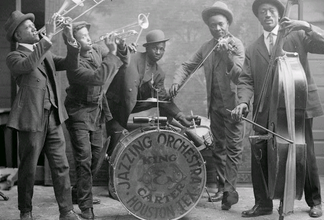 King & Carter Jazzing Orchestra, Houston, Texas, 1921
King & Carter Jazzing Orchestra, Houston, Texas, 1921
The collective improvisation of Dixieland jazz partly symbolized, African Americans' newfound freedom. Although they were hardly experiencing civil rights, African Americans were no longer slaves and celebrated their newfound freedom through jazz improvisation, playing whatever they wanted. They were not "restricted" to notes written on a page, but instead could play whatever they "heard" in their hearts and minds. The music was not read, it was played "by ear". Freedom was and continues to be an important issue regarding all styles of jazz.
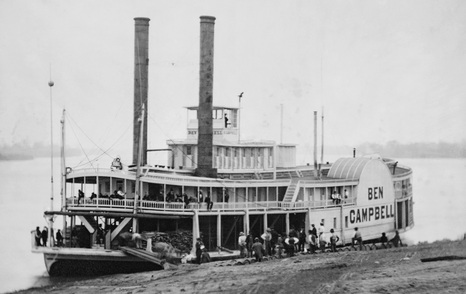 Jazz traveled up the Mississippi River and tributaries on riverboats
Jazz traveled up the Mississippi River and tributaries on riverboats
At the turn of the century, riverboat cruises traveling up the Mississippi River and its tributaries began to become a popular thing to do. Riverboat companies started hiring jazz musicians to entertain passengers on these riverboats. Soon, jazz music began to spread to other major cities along the Mississippi and tributaries. Jazz made its way from New Orleans to Memphis, Saint Louis, Kansas City, Chicago, and New York; then to the rest of the country and eventually the world. Dixieland was the music of city life during the Roaring Twenties and the early years of the Harlem Renaissance.
Jazz in America Timeline
The Path of Jazz Migration Map
DISCUSSION QUESTIONS
As a class, we will discuss the questions. You will answer these questions in your portfolio in PQA format. An example portfolio entry is embedded below.
- What major cultures of music combined to form jazz music?
- How did these cultures contribute to the development of jazz?
- How did the location of New Orleans play a part in the development of jazz?
- What was Dixieland Jazz?
- What did Dixieland Jazz symbolize for African Americans in the South? Why?
- How did Jazz first spread through the United States?
Name Homeroom
Lesson 7.3: The First American Art Form
Lesson Mission: I can describe how Jazz developed and explain why it spread in the 1920s.
Discussion Questions:
1. The major cultures that came together to create jazz were ____________________
_________________________________________________________________________________.
2. The ________________ culture contributed _______________________________________
to the development of jazz. The ____________________ culture contributed
_________________________________________________ to the development of jazz.
3. The location of New Orleans contributed to the development of jazz because
_________________________________________________________________________________.
4. Dixieland Jazz was ______________________________________________________________.
5. Dixieland Jazz symbolized ____________________________ for African Americans in
the South because _____________________________________________________________.
6. Jazz spread through the United States when ____________________________________.
LESSON REFLECTION
I will play the interactive map activity over the projector for the class. As the interactive plays, take notes on what you learn about how jazz spread all over the United States. When you are done, you will use your notes to create a summary. I have embedded the activity below so that you can play it on your home computer or on your mobile device.
|
As the last section in your portfolio question write a paragraph summary explaining how jazz developed and spread during the 1920s.
Remember, when you write a paragraph to follow the proper paragraph structure below:
You need help with structure click on the icon to the right to read about, How to Write a Paragraph. |
Name Homeroom
Lesson 7.3: The First American Art Form
Lesson Mission: I can describe how Jazz developed and explain why it spread in the 1920s.
Discussion Questions:
1. The major cultures that came together to create jazz were ____________________
_________________________________________________________________________________.
2. The ________________ culture contributed _______________________________________
to the development of jazz. The ____________________ culture contributed
_________________________________________________ to the development of jazz.
3. The location of New Orleans contributed to the development of jazz because
_________________________________________________________________________________.
4. Dixieland Jazz was ______________________________________________________________.
5. Dixieland Jazz symbolized ____________________________ for African Americans in
the South because _____________________________________________________________.
6. Jazz spread through the United States when ____________________________________.
Lesson Reflection:
Write your summary about how Jazz spread throughout the United States here.
THE FIRST AMERICAN ART FORM QUIZ
|
On your own, answer the quiz questions in the quiz below. When you finish the quiz write the answers in your portfolio. I have set up the questions for you in the sample portfolio below. You will need to add the answers. To take the quiz, click on the quiz icon to the right.
|
Name Homeroom
Lesson 7.3: The First American Art Form
Lesson Mission: I can describe how Jazz developed and explain why it spread in the 1920s.
Discussion Questions:
1. The major cultures that came together to create jazz were ____________________
_________________________________________________________________________________.
2. The ________________ culture contributed _______________________________________
to the development of jazz. The ____________________ culture contributed
_________________________________________________ to the development of jazz.
3. The location of New Orleans contributed to the development of jazz because
_________________________________________________________________________________.
4. Dixieland Jazz was ______________________________________________________________.
5. Dixieland Jazz symbolized ____________________________ for African Americans in
the South because _____________________________________________________________.
6. Jazz spread through the United States when ____________________________________.
Lesson Reflection:
Write your summary about how Jazz spread throughout the United States here.
Lesson Quiz
1. Which word is a way of thinking, behaving, or doing something that
has been used by the people in a particular group, family, society, etc., for a long
time? __________________________________.
2. Which word is used to describe when a soloist plays whatever they wanted, not
by reading music, but playing by ear? ___________________________________.
3. Which word is the earliest form of jazz that developed from ragtime,
marching bands, the blues, and gospel music? ______________________________.
4. Which words means to improve, develop, or change gradually over a period of
time? ______________________________.
5. Which word means the cause or source of something? _________________________.
6. Paintings, sculptures, music, theatre, and dance are all called
______________________.
7. What city was the major port city in Louisiana, located at the mouth of the
Mississippi River, on the Gulf of Mexico and was the birthplace of Jazz?
_________________________.
8. What is the line that forms by people or cars when moving from a funeral in a
church to the gravesite? __________________________.
9. What are smaller rivers, creeks, or streams that stem off of a bigger, major
rivers? ______________________________.
10. Who was the first great jazz soloist or improviser and one of the most
important figures in jazz history? _________________________________.
LESSON CHECKLIST
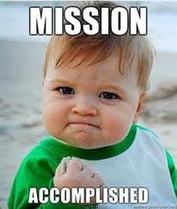
You have accomplished your mission after you have done the following. If you are absent, you need to do the following to complete your missed work.
- Read the class reading.
- Create a portfolio entry.
- List the portfolio entry in your table of contents.
- Answer the discussion questions in your portfolio.
- Take the Lesson 7.3: The First American Art Form Quiz.
- Record the quiz questions and answers in your portfolio.
- Complete the lesson reflection in your portfolio.
- If you finish early, go ahead and start studying for the test by playing the Lesson 7.3. First American Art Form Arcade Games .
STUDY ARCADE
Click on any of the icons to play that game.
